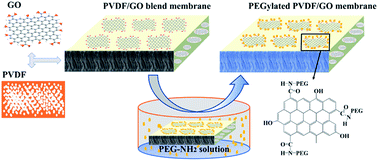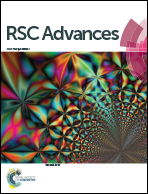PEGylated polyvinylidene fluoride membranes via grafting from a graphene oxide additive for improving permeability and antifouling properties
Abstract
Polyvinylidene fluoride (PVDF) porous membranes with enhanced hydrophilicity and antifouling performance were developed via surface PEGylation (PEG, polyethylene glycol) via a reactive graphene oxide (GO) additive. PVDF/GO blended membranes were first fabricated via a non-solvent-induced phase separation process. Then the carboxyl groups of GO sheets immobilized on the membrane surface acted as initiating sites for grafting amine-functionalized PEG (PEG-NH2) chains via an amination reaction. Analysis of the X-ray photoelectron spectroscopy and Fourier transform infrared spectroscopy-attenuated total reflectance results confirmed the successful grafting of hydrophilic PEG molecular chains on PVDF membrane surfaces. The water contact angle of the PEGylated PVDF membrane decreased to 59.9°, indicating improved hydrophilicity. As a result, the antifouling performance was enhanced significantly. After surface PEGylation, the flux recovery rate is reached 90.2%, the total fouling ratio was as low as 20.7%, and reversible fouling plays a dominant role during the membrane fouling process. This work provides a valuable strategy to fabricate PEGylated membranes via the introduction of a reactive GO additive.



 Please wait while we load your content...
Please wait while we load your content...